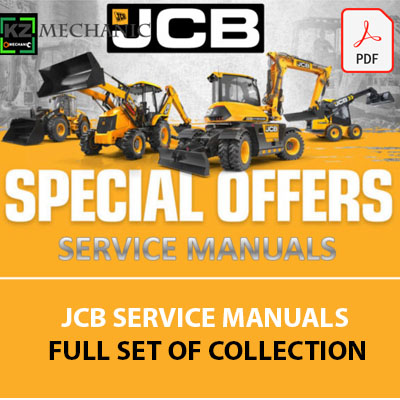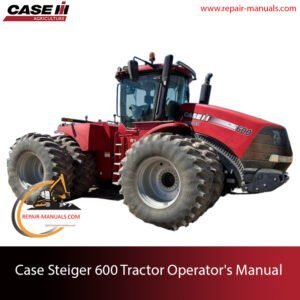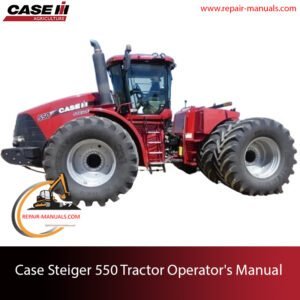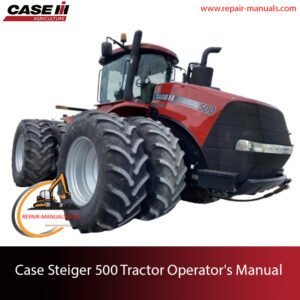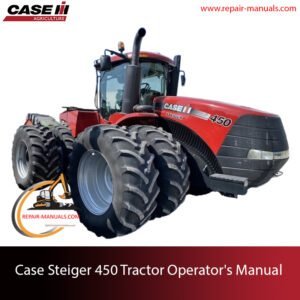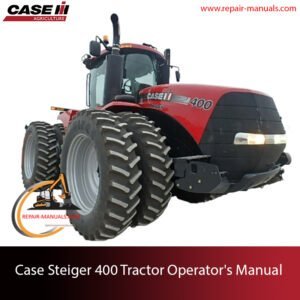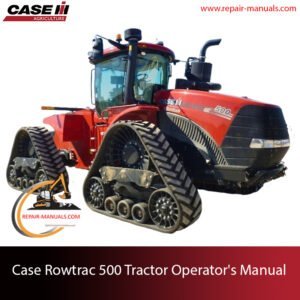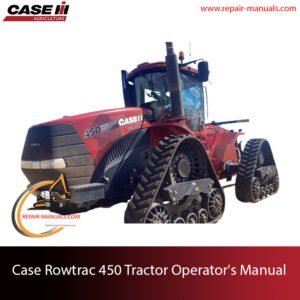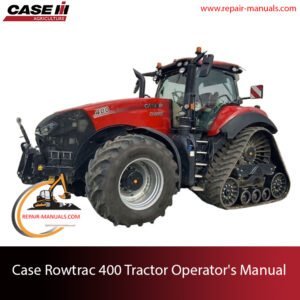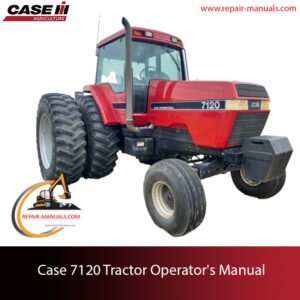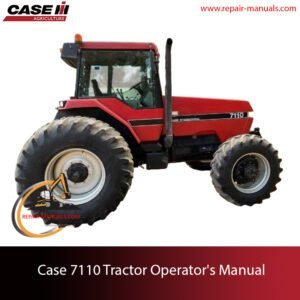ADVERTICEMENT
JCB 3C 3CX 4CX Backhoe Loader Service Manual
Backhoe Loader | ||||||||
Section 1 - General Information | ||||||||
Section 2 - Care and Safety | ||||||||
Section 3 - Maintenance | ||||||||
Section A - Attachments | ||||||||
Section B - Body and Framework | ||||||||
Section C - Electrics | ||||||||
Section D - Controls | ||||||||
Section E - Hydraulics | ||||||||
Section F - Transmission | ||||||||
Section G - Brakes | ||||||||
Section H - Steering | ||||||||
Section K - Engine | ||||||||
Section L - Servo Controls | ||||||||
Publication No. 9803/3290-16 | ||||||||
World Class Customer Support | ||||||||
Copyright © 2004 JCB SERVICE. All rights reserved. No part of this publication may be reproduced, stored in a retrieval system, or transmitted in any form or by any other means, electronic, mechanical, photocopying or otherwise, without prior permission from JCB SERVICE. |
General Information | ||||||||
Service Manual - Backhoe Loader | ||||||||
Section 1 - General Information | ||||||||
Section 2 - Care and Safety | ||||||||
Section 3 - Maintenance | ||||||||
Section A - Attachments | ||||||||
Section B - Body and Framework | ||||||||
Section C - Electrics | ||||||||
Section D - Controls | ||||||||
Section E - Hydraulics | ||||||||
Section F - Transmission | ||||||||
Section G - Brakes | ||||||||
Section H - Steering | ||||||||
Section K - Engine | ||||||||
Section L - Servo Controls | ||||||||
Publication No. 9803/3290-16 | ||||||||
World Class Customer Support | ||||||||
Copyright © 2004 JCB SERVICE. All rights reserved. No part of this publication may be reproduced, stored in a retrieval system, or transmitted in any form or by any other means, electronic, mechanical, photocopying or otherwise, without prior permission from JCB SERVICE. |
Notes:
Contents Introduction
Page No.
About this Publication 1-1
Using the Service Manual 1-1
Section Numbering 1-1
Units of Measurement 1-1
Left Side, Right Side 1-2
Cab/Canopy 1-2
Cross References 1-2
Machine Nomenclature 1-2
Identifying the Machine 1-3
Machine Identification Plate 1-3
Component Identification Plates 1-4
Fuel 1-8
Types of Fuel 1-8
Torque Settings
Zinc Plated Fasteners and Dacromet Fasteners 1-11
Introduction 1-11
Bolts and Screws 1-11
Hydraulic Connections 1-15
'O' Ring Face Seal System 1-15
'Torque Stop' Hose System 1-18
`Quick-Connect' Pilot Hoses 1-19
Disconnecting 1-19
Connecting 1-19
Service Tools
Numerical List 1-20
Service Aids
Sealing and Retaining Compounds 1-23
Terms and Definitions
Colour Coding 1-24
Hydraulic Schematic Colour Codes 1-24
Contents Page No.
Introduction
About this Publication
About this Publication
This publication contains topics that relate to JCB 3C, 3CX and 4CX Backhoe Loaders described below:
Machines from serial no. 960001 to 989999; 1327000
to 1349999; and 1616000 to 1625999.
North American machines from serial no. 907001 to 919999.
Chinese machines from serial no. 1297000 to 1349999.
Using the Service Manual
specifications of the machine and the descriptions contained in this publication.
Finally, please remember above all else safety must come first!
Section Numbering
T11-005
The manual is compiled in sections, the first three are numbered and contain information as follows:
T11-004
This publication is designed for the benefit of JCB Distributor Service Engineers who are receiving, or have received, training by JCB Technical Training Department.
These personnel should have a sound knowledge of workshop practice, safety procedures, and general techniques associated with the maintenance and repair of hydraulic earthmoving equipment.
The illustrations in this publication are for guidance only. Where the machines differ, the text and/or the illustration will specify.
General warnings in Section 2 are repeated throughout the manual, as well as specific warnings. Read all safety statements regularly, so you do not forget them.
Renewal of oil seals, gaskets, etc., and any component showing obvious signs of wear or damage is expected as a matter of course. It is expected that components will be cleaned and lubricated where appropriate, and that any opened hose or pipe connections will be blanked to prevent excessive loss of hydraulic fluid and ingress of dirt.
Where a torque setting is given as a single figure it may be varied by plus or minus 3%. Torque figures indicated are for dry threads, hence for lubricated threads may be reduced by one third.
The manufacturer's policy is one of continuous improvement. The right to change the specification of the machine without notice is reserved. No responsibility will be accepted for discrepancies which may occur between
General Information - includes torque settings and service tools.
Care and Safety - includes warnings and cautions pertinent to aspects of workshop procedures etc.
Maintenance - includes service schedules and recommended lubricants for all the machine.
The remaining sections are alphabetically coded and deal with Dismantling, Overhaul etc. of specific components, for example:
Attachments
Body and Framework, etc.
Section contents, technical data, circuit descriptions, operation descriptions etc. are inserted at the beginning of each alphabetically coded section.
Units of Measurement
T1-001_2
In this publication, the S.I. system of units is used. For example, liquid capacities are given in litres. The Imperial units follow in parentheses ( ) eg 28 litres (6 gal).
Left Side, Right Side
P2-1002
Machine Nomenclature
About this Publication
In this manual, 'left' A and 'right' B mean your left and right when you are seated correctly in the machine.
This is so whether you are facing the loader (front) or the backhoe (rear).
A
B
In this Service Manual, reference is made to machine models, e.g. 3CX, 4CX, these are European machine model names. North American machine models have different names, the tables below show the European and the equivalent North American nomenclature.
Table 1. Up to March 2006
European: | North American: |
3CX | 214, 215, 217 |
4CX | 214S, 215S, 217S |
- | 214e, 214e LL (Landscaper), 215E |
Table 2. From March 2006
A
B
European: | North American: |
3CX | 3CX 14, 3CX 15, 3CX 17 |
4CX | 4CX 14, 4CX 15, 4CX 17 |
3C | 3C 14, 3C LL, 3C 15 |
Cab/Canopy
Fig 1.
C003690
T1-003_2
This manual frequently makes references to the cab. For instance, 'do not operate the machine without a manual in the cab'. It should be noted that these statements also apply to canopy build machines.
Cross References
T1-004_2
In this publication, page cross references are made by presenting the subject title printed in bold, italic and underlined. It is preceeded by the 'go to' symbol. The number of the page upon which the subject begins, is indicated within the brackets. For example: K Cross References ( 1-2).
Identifying the Machine
Identifying the Machine
Machine Identification Plate
The machine has an identification plate mounted on the loader tower. The serial numbers of the machine and its major units are stamped on the plate.
The serial number of each major unit is also stamped on the unit itself. If a major unit is replaced by a new one, the serial number on the identification plate will be wrong. Either stamp the new number of the unit on the identification plate, or simply stamp out the old number. This will prevent the wrong unit number being quoted when replacement parts are ordered.
The machine and engine serial numbers can help identify exactly the type of equipment you have.
Year of Manufacture:
4 = 2004
5 = 2005
6 = 2006
7 = 2007
Manufacturer Location (E = England)
Machine Serial Number
Typical Product Identification Number (PIN)
P2-1006
Fig 2.
World Manufacturer Identification (3 Digits)
Machine Model (5 Digits)
Check Letter (1 Digit)
T016220-8
The Check Letter is used to verify the authenticity of a machine's PIN.
Machine Serial Number (8 Digits)
Each machine has a unique serial number.
Typical Vehicle Identification Number (VIN)
SLP 3CX | T | S | 2 | E | 0960001 |
1 2 | 3 | 4 | 5 | 6 | 7 |
World Manufacturer Identification
Machine Model
Steer Type (T= 2WS, F= 4WS)
Build Type (S=Sideshift, C=Centremount, L=Loader)
Fig 3. U.K and R.O.W
Fig 4. North America
T025210-1
Component Identification Plates
Typical Engine Identification Number
T1-005_3
Identifying the Machine
E
Engine data labels A are located on the cylinder block at position C and rocker cover D (if fitted). K Fig 5. ( 1-4).
The data label contains important engine information and
D
B
C
B
includes the engine identification number E.
A typical engine identification number is explained as follows:
SA | 320/40001 | U | 00001 | 04 |
1 | 2 | 3 | 4 | 5 |
Engine Type
S = 4.4 litre series.
JCB Dieselmax (Tier 2)
A = Naturally aspirated
B = Turbocharged
C = Turbocharged and intercooled
JCB Dieselmax (Tier 3)
D = Turbocharged
E = Electronic common rail fuel injection
F = Turbocharged and after-cooled
Fig 5. Engine
C007820-C2
Engine part number
Country of manufacture U = United Kingdom
Engine Serial Number
Year of Manufacture
The last three parts of the engine identification number are stamped on the cylinder block at position B.
U 00001 04
Transmission Identification Numbers
Axles
The axles have a serial number stamped on a data plate as shown.
Fig 6. Front Axle (2WS machine)
Fig 7. Front Axle (4WS machine)
Fig 8. Rear Axle (2WS machine)
Identifying the Machine
Fig 9. Rear Axle (4WS machine)
Gearbox
The gearbox has a serial number stamped on a data plate as shown.
A
Fig 10. Synchro Shuttle Transmission
Identifying the Machine
ROPS/FOPS Certification plate
Fig 12. Cab
Machines built to ROPS/FOPS standards have an identification label fitted to the inside of the cab. K Fig 12. ( 1-6).
The FOPS structure provides Level II Impact Protection against falling objects (as defined in ISO 3449:2005).
Definition of terms:
ROPS Roll Over Protection Structure FOPS Falling Objects Protection Structure
A
FOPS Data Plate
WARNING
Do not use the machine if the falling objects protection level provided by the structure is not sufficient for the application. Falling objects can cause serious injury.
8-2-8-17
If the machine is used in any application where there is a risk of falling objects then a falling-objects protective structure (FOPS) must be installed. For further information contact your JCB Dealer
Fig 11. Powershift Transmission
The falling objects protection structure (FOPS) is fitted with a dataplate. The dataplate indicates what level protection the structure provides.
There are two levels of FOPS:
Identifying the Machine
Level I Impact Protection - impact strength for protection from small falling objects (e.g. bricks, small concrete blocks, hand tools) encountered in operations such as highway maintenance, landscaping and other construction site services.
Level II Impact Protection - impact strength for protection from heavy falling objects (e.g. trees, rocks) for machines involved in site clearing, overhead demolition or forestry.
Types of Fuel
Fuel
CAUTION
Fuel
Acceptable and Unacceptable Fuels
T3-031
Consult your fuel supplier or JCB distributor about the suitability of any fuel you are unsure of.
Important: No warranty liability whatsoever will be accepted for failure of fuel injection equipment where the failure is attributed to the quality and grade of the fuel used.
GEN-9-2
Table 3.
Fuel Specification | Applicable Engines | Service Requirements | |||||
EN590 Diesel fuel types | - Auto/C0/C1/C2/ | All Dieselmax engines. | Obey | the | usual | routine | |
C3/C4 | maintenence | schedules | and | ||||
procedures. | |||||||
BS2869 Class A2 | |||||||
ASTM D975-91 Class 2, US DF1, US DF2, | |||||||
US DFA | |||||||
JIS K2204 (1992) Grades 1, 2, 3 and Special | |||||||
Grade 3 | |||||||
ASTM D975-91 Class 1DA | All Dieselmax engines. Important: Engines operated with these fuels may have a reduced service life. | Obey the usual routine maintenence schedules and procedures. Fuel additives are recommended for use with low sulphur fuels. K Additives ( 1-9). | |||||
MIL T38219 XF63 | |||||||
NATO F63 | |||||||
French EN590 (RME5) with 5% maximum | |||||||
AVTURFSII, NATO F34, JP8, MIL T83133, DERD 2463, DEF STAN 91-87 | All Dieselmax engines. Important: Engines operated with these fuels may have a reduced service life. | Obey the usual routine maintenence schedules and procedures. Fuel additives must be used. K Additives ( 1-9). | |||||
AVCAT FSII, NATO F44, JP5, MIL T5624, DERD 2452, AVTOR | |||||||
NATO F35, JET A1, DERD 2494, JP7 | DEF STAN 91-91, | ||||||
AVCAT, NATO F43 (obsolete), JP5 without additives | |||||||
JET A (ASTM D1655) | |||||||
ASTM D3699 Kerosene | |||||||
B20 Biodiesel - RME content blended with | Dieselmax engines manufactured | You | must | obey | special | routine | |
mineral derived diesel (20% maximum) - | from 2007 on only(1). | maintenance schedules and | |||||
ASTM D6751, DIN 51606, ISO 14214 | procedures. K Warranty ( 1-9). | ||||||
AVTAG (obsolete) | These fuels are not acceptable with or without additives. Engines must not be operated with these fuels. | ||||||
AVTAG FSII (obsolete), DERD 2454 | NATO F40, | JP4, | |||||
JET B (ASTM D1655) | |||||||
BS MA100 | |||||||
JIS K2203 No.2 | |||||||
Unmodified vegetable oils | |||||||
(1) The year of manufacture is part of the engine serial number. Refer to Typical Engine Identification Number.
Additives
The additives listed below are advertised as being suitable for bringing the lubricity levels of kerosene/low sulphur fuels up to those of diesel fuels. They must be used as specified by your fuel supplier who will understand the concentration level necessary.
– Elf 2S 1750. Dosage 1000-1500 ppm (0.1 - 0.15%),
specifically for Indian Superior Kerosene (SKO) but may be applicable to other fuels.
Lubrizol 539N. Dosage (on Swedish low sulphur fuel) 250 ppm.
Paradyne 7505 (from Infineum). Dosage 500 ppm (0.05%).
Note: These products are given as examples only. The information is derived from the manufacturers data. The products are not recommended or endorsed by JCB.
Service Requirements for use of B20 Biodiesel
The engine oil must be a grade CH4 as minimum specification.
Do not leave unused B20 biodiesel in the fuel tank for extended periods (top up each day).
Make sure that 1 in 5 fuel tank fills use standard diesel to EN590 specification, this will help to prevent 'gumming'.
Make sure regular oil sampling is completed (look for excessive unburnt fuel content, water or wear particles.
Change the engine oil and filter more frequently (as a minimum half the recommended intervals), or as indicated by oil sampling.
Change the fuel filters more frequently (as a minimum half the recommended intervals), or if there are engine performance related issues.
Make sure the fuel is stored correctly, care must be taken to make sure no water enters the machine fuel tank (or the storage tank). Water will encourage mico- bacterial growth.
Make sure that the fuel pre-filter is drained daily (not every week as currently advised).
Only JCB engines built after Jan. 2007 are applicable (i.e. engines with 07 on the end of their serial number
Fuel
and factory filled with CH4 oil) - this is not approved with other manufacturers.
Use heater kits in low ambient temperature territories.
The biodiesel must meet the following standards: ASTM D6751, DIN 51606, ISO 14214
Note: If necessary use a test kit to confirm the fuel specification. Testing kits are available (not from JCB currently), use the internet as a source for the kits.
Note: If performance related issues are to be reported to JCB Service, and the engine has been run on biodiesel, then the fuel system must be filled with standard diesel (at least 2 x tank fills) to EN590 specification and relevant stall speeds recorded prior to making the report.
Warranty
JCB have shown a commitment to support the environment by approving the use of biodiesel blended fuels.
Using a B20 blend of biodiesel requires caution and additional servicing of the engine is required. K Service Requirements for use of B20 Biodiesel ( 1-9).
Failure to follow the additional recommended service requirements may lead to a warranty claim being declined.
Failures resulting by the incorrect use of biodiesels or other fuel additives are not defects of the JCB Dieselmax engine workmanship and therefore will not be supported by JCB Warranty.
Sulphur Content
T3-032
Effects of Fuel Contaminates
Fuel
T3-033
High sulphur content can cause engine wear. (High sulphur fuel is not normally found in North America, Europe or Australia.) If you have to use high sulphur fuel you must change the engine oil more frequently. K Table 4. Sulphur Content ( 1-10).
Low sulphur fuels must have the appropriate fuel lubricity additives, these lubricity improvers must not create residual deposits that block the fuel system, e.g. injectors, filters etc. Contact your fuel Supplier.
CAUTIONA combination of water and sulphur will have a corrosive chemical effect on fuel injection equipment. It is essential that water is eradicated from the fuel system when high sulphur fuels are used.
ENG-3-2
Percentage of sulphur in the fuel (%)
Oil Change Interval
Less than 0.5
Normal
0.5 to 1.0
0.75 of normal
More than 1.0
0.50 of normal
Table 4. Sulphur Content
The effect of dirt, water and other contaminants in diesel can be disastrous for injection equipment:
Dirt - A severely damaging contaminant. Finely machined and mated surfaces such as delivery valves and distributor rotors are susceptible to the abrasive nature of dirt particles - increased wear will almost inevitably lead to greater leakage, uneven running and poor fuel delivery.
Water - Water can enter fuel through poor storage or careless handling, and will almost inevitably condense in fuel tanks. The smallest amounts of water can result in effects that are just as disastrous to the fuel injection pump as dirt, causing rapid wear, corrosion and in severe cases, even seizure. It is vitally important that water is prevented from reaching the fuel injection equipment. The filter/water trap must be drained regularly.
Wax - Wax is precipitated from diesel when the ambient temperature falls below that of the fuel's cloud point, causing a restriction in fuel flow resulting in rough engine running. Special winter fuels may be available for engine operation at temperatures below 0°C (32°F). These fuels have a lower viscosity and limit wax formation.
Zinc Plated Fasteners and Dacromet Fasteners
Torque Settings
Zinc Plated Fasteners and Dacromet Fasteners
Introduction
Some external fasteners on JCB machines are manufactured using an improved type of corrosion resistant finish. This type of finish is called Dacromet and replaces the original Zinc and Yellow Plating used on earlier machines.
The two types of fasteners can be readily identified by colour and part number suffix. K Table 5. Fastener Types ( 1-11).
Table 5. Fastener Types
Fastener Type | Colour | Part No. Suffix |
Zinc and Yellow | Golden finish | 'Z' (e.g. 1315/3712Z) |
Dacromet | Mottled silver finish | 'D' (e.g. 1315/3712D) |
Note: As the Dacromet fasteners have a lower torque setting than the Zinc and Yellow fasteners, the torque figures used must be relevant to the type of fastener.
Note: A Dacromet bolt should not be used in conjunction with a Zinc or Yellow plated nut, as this could change the torque characteristics of the torque setting further. For the same reason, a Dacromet nut should not be used with a Zinc or Yellow plated bolt.
Note: All bolts used on JCB machines are high tensile and must not be replaced by bolts of a lesser tensile specification.
Note: Dacromet bolts, due to their high corrosion resistance are used in areas where rust could occur. Dacromet bolts are only used for external applications. They are not used in applications such as gearbox or engine joint seams or internal applications.
T11-002
Bolts and Screws
Use the following torque setting tables only where no torque setting is specified in the text.
Note: Dacromet fasteners are lubricated as part of the plating process, do not lubricate.
Torque settings are given for the following conditions:
Condition 1
Un-lubricated fasteners
Zinc fasteners
Yellow plated fasteners
Condition 2
Zinc flake (Dacromet) fasteners
Lubricated zinc and yellow plated fasteners
Where there is a natural lubrication. For example, cast iron components
Verbus Ripp Bolts
Fig 13.
Torque settings for these bolts are determined by the application. Refer to the relevant procedure for the required settings.
Zinc Plated Fasteners and Dacromet Fasteners
Table 6. Torque Settings - UNF Grade 'S' Fasteners
Bolt Size | Hexagon (A/F) | Condition 1 | Condition 2 | |||||
in. | mm | in. | Nm | kgf m | lbf ft | Nm | kgf m | lbf ft |
1/4 | 6.3 | 7/16 | 11.2 | 1.1 | 8.3 | 10.0 | 1.0 | 7.4 |
5/16 | 7.9 | 1/2 | 22.3 | 2.3 | 16.4 | 20.0 | 2.0 | 14.7 |
3/8 | 9.5 | 9/16 | 40.0 | 4.1 | 29.5 | 36.0 | 3.7 | 26.5 |
7/16 | 11.1 | 5/8 | 64.0 | 6.5 | 47.2 | 57.0 | 5.8 | 42.0 |
1/2 | 12.7 | 3/4 | 98.00 | 10.0 | 72.3 | 88.0 | 9.0 | 64.9 |
9/16 | 14.3 | 13/16 | 140.0 | 14.3 | 103.2 | 126.0 | 12.8 | 92.9 |
5/8 | 15.9 | 15/16 | 196.0 | 20.0 | 144.6 | 177.0 | 18.0 | 130.5 |
3/4 | 19.0 | 1 1/8 | 343.0 | 35.0 | 253.0 | 309.0 | 31.5 | 227.9 |
7/8 | 22.2 | 1 15/16 | 547.0 | 55.8 | 403.4 | 492.0 | 50.2 | 362.9 |
1 | 25.4 | 1 1/2 | 814.0 | 83.0 | 600.4 | 732.0 | 74.6 | 539.9 |
1 1/8 | 31.7 | 1 7/8 | 1181.0 | 120.4 | 871.1 | 1063.0 | 108.4 | 784.0 |
1 1/4 | 38.1 | 2 1/4 | 1646.0 | 167.8 | 1214.0 | 1481.0 | 151.0 | 1092.3 |
Table 7. Torque Settings - Metric Grade 8.8 Fasteners
Bolt Size | Hexagon (A/F) | Condition 1 | Condition 2 | |||||
ISO Metric Thread | mm | mm | Nm | kgf m | lbf ft | Nm | kgf m | lbf ft |
M5 | 5 | 8 | 5.8 | 0.6 | 4.3 | 5.2 | 0.5 | 3.8 |
M6 | 6 | 10 | 9.9 | 1.0 | 7.3 | 9.0 | 0.9 | 6.6 |
M8 | 8 | 13 | 24.0 | 2.4 | 17.7 | 22.0 | 2.2 | 16.2 |
M10 | 10 | 17 | 47.0 | 4.8 | 34.7 | 43.0 | 4.4 | 31.7 |
M12 | 12 | 19 | 83.0 | 8.5 | 61.2 | 74.0 | 7.5 | 54.6 |
M16 | 16 | 24 | 205.0 | 20.9 | 151.2 | 184.0 | 18.8 | 135.7 |
M20 | 20 | 30 | 400.0 | 40.8 | 295.0 | 360.0 | 36.7 | 265.5 |
M24 | 24 | 36 | 690.0 | 70.4 | 508.9 | 621.0 | 63.3 | 458.0 |
M30 | 30 | 46 | 1372.0 | 139.9 | 1011.9 | 1235.0 | 125.9 | 910.9 |
M36 | 36 | 55 | 2399.0 | 244.6 | 1769.4 | 2159.0 | 220.0 | 1592.4 |
Zinc Plated Fasteners and Dacromet Fasteners
Table 8. Metric Grade 10.9 Fasteners
Bolt Size | Hexagon (A/F) | Condition 1 | Condition 2 | |||||
ISO Metric Thread | mm | mm | Nm | kgf m | lbf ft | Nm | kgf m | lbf ft |
M5 | 5 | 8 | 8.1 | 0.8 | 6.0 | 7.3 | 0.7 | 5.4 |
M6 | 6 | 10 | 13.9 | 1.4 | 10.2 | 12.5 | 1.3 | 9.2 |
M8 | 8 | 13 | 34.0 | 3.5 | 25.0 | 30.0 | 3.0 | 22.1 |
M10 | 10 | 17 | 67.0 | 6.8 | 49.4 | 60.0 | 6.1 | 44.2 |
M12 | 12 | 19 | 116.0 | 11.8 | 85.5 | 104.0 | 10.6 | 76.7 |
M16 | 16 | 24 | 288.0 | 29.4 | 212.4 | 259.0 | 26.4 | 191.0 |
M20 | 20 | 30 | 562.0 | 57.3 | 414.5 | 506.0 | 51.6 | 373.2 |
M24 | 24 | 36 | 971.0 | 99.0 | 716.9 | 874.0 | 89.1 | 644.6 |
M30 | 30 | 46 | 1930.0 | 196.8 | 1423.5 | 1737.0 | 177.1 | 1281.1 |
M36 | 36 | 55 | 3374.0 | 344.0 | 2488.5 | 3036.0 | 309.6 | 2239.2 |
Table 9. Metric Grade 12.9 Fasteners
Bolt Size | Hexagon (A/F) | Condition 1 | Condition 2 | |||||
ISO Metric Thread | mm | mm | Nm | kgf m | lbf ft | Nm | kgf m | lbf ft |
M5 | 5 | 8 | 9.8 | 1.0 | 7.2 | 8.8 | 0.9 | 6.5 |
M6 | 6 | 10 | 16.6 | 1.7 | 12.2 | 15.0 | 1.5 | 11.1 |
M8 | 8 | 13 | 40.0 | 4.1 | 29.5 | 36.0 | 3.7 | 26.5 |
M10 | 10 | 17 | 80.0 | 8.1 | 59.0 | 72.0 | 7.3 | 53.1 |
M12 | 12 | 19 | 139.0 | 14.2 | 102.5 | 125.0 | 12.7 | 92.2 |
M16 | 16 | 24 | 345.0 | 35.2 | 254.4 | 311.0 | 31.7 | 229.4 |
M20 | 20 | 30 | 674.0 | 68.7 | 497.1 | 607.0 | 61.9 | 447.7 |
M24 | 24 | 36 | 1165.0 | 118.8 | 859.2 | 1048.0 | 106.9 | 773.0 |
M30 | 30 | 46 | 2316.0 | 236.2 | 1708.2 | 2084.0 | 212.5 | 1537.1 |
M36 | 36 | 55 | 4049.0 | 412.9 | 2986.4 | 3644.0 | 371.6 | 2687.7 |
Zinc Plated Fasteners and Dacromet Fasteners
Table 10. Torque Settings - Rivet Nut Bolts/Screws
Bolt Size | Nm | kgf m | lbf ft | |
ISO Metric Thread | mm | |||
M3 | 3 | 1.2 | 0.1 | 0.9 |
M4 | 4 | 3.0 | 0.3 | 2.0 |
M5 | 5 | 6.0 | 0.6 | 4.5 |
M6 | 6 | 10.0 | 1.0 | 7.5 |
M8 | 8 | 24.0 | 2.5 | 18.0 |
M10 | 10 | 48.0 | 4.9 | 35.5 |
M12 | 12 | 82.0 | 8.4 | 60.5 |
Table 11. Torque Settings - Internal Hexagon Headed Cap Screws (Zinc)
Bolt Size | Nm | kgf m | lbf ft |
ISO Metric Thread | |||
M3 | 2.0 | 0.2 | 1.5 |
M4 | 6.0 | 0.6 | 4.5 |
M5 | 11.0 | 1.1 | 8.0 |
M6 | 19.0 | 1.9 | 14.0 |
M8 | 46.0 | 4.7 | 34.0 |
M10 | 91.0 | 9.3 | 67.0 |
M12 | 159.0 | 16.2 | 117.0 |
M16 | 395.0 | 40.0 | 292.0 |
M18 | 550.0 | 56.0 | 406.0 |
M20 | 770.0 | 79.0 | 568.0 |
M24 | 1332.0 | 136.0 | 983.0 |
'O' Ring Face Seal System
Hydraulic Connections
T11-003
Hydraulic Connections
Adaptors Screwed into Valve Blocks
Adaptor screwed into valve blocks, seal onto an 'O' ring which is compressed into a 45° seat machined into the face of the tapped port.
Table 12. Torque Settings - BSP Adaptors
BSP Adaptor Size | Hexagon (A/F) | Nm | kgf m | lbf ft |
in. | mm | |||
1/4 | 19.0 | 18.0 | 1.8 | 13.0 |
3/8 | 22.0 | 31.0 | 3.2 | 23.0 |
1/2 | 27.0 | 49.0 | 5.0 | 36.0 |
5/8 | 30.0 | 60.0 | 6.1 | 44.0 |
3/4 | 32.0 | 81.0 | 8.2 | 60.0 |
1 | 38.0 | 129.0 | 13.1 | 95.0 |
1 1/4 | 50.0 | 206.0 | 21.0 | 152.0 |
Table 13. Torque Settings - SAE Connections
SAE Tube Size | SAE Port Thread Size | Hexagon (A/F) | Nm | kgf m | lbf ft |
mm | |||||
4 | 7/16 - 20 | 15.9 | 20.0 - 28.0 | 2.0 - 2.8 | 16.5 - 18.5 |
6 | 9/16 - 18 | 19.1 | 46.0 - 54.0 | 4.7 - 5.5 | 34.0 - 40.0 |
8 | 3/4 - 16 | 22.2 | 95.0 - 105.0 | 9.7 - 10.7 | 69.0 - 77.0 |
10 | 7/8 - 14 | 27.0 | 130.0 - 140.0 | 13.2 - 14.3 | 96.0 - 104.0 |
12 | 1 1/16 - 12 | 31.8 | 190.0 - 210.0 | 19.4 - 21.4 | 141.0 - 155.0 |
16 | 1 5/16 - 12 | 38.1 | 290.0 - 310.0 | 29.6 - 31.6 | 216.0 - 230.0 |
20 | 1 5/8 | 47.6 | 280.0 - 380.0 | 28.5 - 38.7 | 210.0 - 280.0 |
Hydraulic Connections
Hoses Screwed into Adaptors
Fig 14.
Hoses 14-B screwed into adaptors 14-A seal onto an `O' ring 14-C which is compressed into a 45° seat machined into the face of the adaptor port.
Note: Dimension 14-D will vary depending upon the torque applied.
Table 14. BSP Hose - Torque Settings
BSP Hose Size | Hexagon (A/F) | Nm | kgf m | lbf ft |
in. | mm | |||
1/8 | 14.0 | 14.0 - 16.00 | 1.4 - 1.6 | 10.3 - 11.8 |
1/4 | 19.0 | 24.0 - 27.0 | 2.4 - 2.7 | 17.7 - 19.9 |
3/8 | 22.0 | 33.0 - 40.0 | 3.4 - 4.1 | 24.3 - 29.5 |
1/2 | 27.0 | 44.0 - 50.0 | 4.5 - 5.1 | 32.4 - 36.9 |
5/8 | 30.0 | 58.0 - 65.0 | 5.9 - 6.6 | 42.8 - 47.9 |
3/4 | 32.0 | 84.0 - 92.0 | 8.6 - 9.4 | 61.9 - 67.8 |
1 | 38.0 | 115.0 - 126.0 | 11.7 - 12.8 | 84.8 - 92.9 |
1 1/4 | 50.0 | 189.0 - 200.0 | 19.3 - 20.4 | 139.4 - 147.5 |
1 1/2 | 55.0 | 244.0 - 260.0 | 24.9 - 26.5 | 180.0 - 191.8 |
Hydraulic Connections
Adaptors into Component Connections with Bonded Washers
Table 15. BSP Adaptors with Bonded Washers - Torque Settings
BSP Size | Nm | kgf m | lbf ft |
in. | |||
1/8 | 20.0 | 2.1 | 15.0 |
1/4 | 34.0 | 3.4 | 25.0 |
3/8 | 75.0 | 7.6 | 55.0 |
1/2 | 102.0 | 10.3 | 75.0 |
5/8 | 122.0 | 12.4 | 90.0 |
3/4 | 183.0 | 18.7 | 135.0 |
1 | 203.0 | 20.7 | 150.0 |
1 1/4 | 305.0 | 31.0 | 225.0 |
1 1/2 | 305.0 | 31.0 | 225.0 |
Hydraulic Connections
'Torque Stop' Hose System
Fig 15.
`Torque Stop' Hoses 15-B screwed into adaptors 15-A seal onto an 'O' ring 15-C which is compressed into a 45° seat machined in the face of the adaptor port. To prevent the 'O' ring being damages as a result of over tightening, 'Torque
Stop' Hoses have an additional shoulder 15-D, which acts as a physical stop.
Note: Minimum dimension 15-E fixed by shoulder 15-D.
Table 16. BSP `Torque Stop' Hose - Torque Settings
BSP Hose Size | Hexagon (A/F) | Nm | kgf m | lbf ft |
in. | mm | |||
1/8 | 14.0 | 14.0 | 1.4 | 10.0 |
1/4 | 19.0 | 27.0 | 2.7 | 20.0 |
3/8 | 22.0 | 40.0 | 4.1 | 30.0 |
1/2 | 27.0 | 55.0 | 5.6 | 40.0 |
5/8 | 30.0 | 65.0 | 6.6 | 48.0 |
3/4 | 32.0 | 95.0 | 9.7 | 70.0 |
1 | 38.0 | 120.0 | 12.2 | 89.0 |
1 1/4 | 50.0 | 189.0 | 19.3 | 140.0 |
1 1/2 | 55.0 | 244.0 | 24.9 | 180.0 |
`Quick-Connect' Pilot Hoses
Some pilot hoses have quick-connect couplings. This type of coupling requires a special tool to release it.
`Quick-Connect' Pilot Hoses
A
B
Fig 16.
Disconnecting
Push on the pilot hose A in the direction shown, and insert the correct tool B. See Service Tools.
Push on the hose, and at the same time use the tool as a lever to release the coupling.
Connecting
Make sure that the hose coupling is clean and the O- rings are not damaged. Apply some clean hydraulic fluid to the O-rings.
Align the coupling directly to the hydraulic port. Push the coupling into the port as far as it will go. The coupling will click when it is fully engaged.
Pull on the hose to verify that the coupling is fully engaged. If the connection is not good the coupling will release very easily.
Service Tools
Numerical List
The tools listed in the table are special tools required for carrying out the procedures described in this manual. These tools are available from JCB Service.
Some tools are available as kits or sets, the part numbers for parts within such kits or sets are not listed here. For full
details of all tools, including the content of kits and sets, see the relevant section in this manual.
Note: Tools other than those listed will be required. It is expected that such general tools will be available in any well equipped workshop or be available locally from any good tool supplier.
Part | Description | Tool Detail Reference |
Number | - see Section: | |
- | AVO Test Kit - see tool detail reference for content | C |
- | Bonded Washers - see tool detail reference for content | E |
- | Female Cone Blanking Plugs - see tool detail reference for content | E |
- | Female Connectors - see tool detail reference for content | E |
- | Hydraulic Flow Test Equipment - see tool detail reference for content | E |
- | Hydraulic Hand Pump Equipment - see tool detail reference for content | E |
- | Male Adaptors - BSP x BSP - see tool detail reference for content | E |
- | Male Adaptors - BSP x NPT (USA only) - see tool detail reference for content | E |
- | Male Cone Blanking Caps - see tool detail reference for content | E |
- | Pressure Test Points - `T' Adaptors - see tool detail reference for content | E |
- | Pressure Test Points - Adaptors - see tool detail reference for content | E |
- | Rivet Nut Tool - see tool detail reference for content | B |
892/01160 | Engine lifting bracket (2-off) | K |
4104/1310 | Hand Cleaner | B |
460/15708 | Flow test adaptor - Powershift - Other components required, see tool detail | F |
716/30313 | Test relay - with LED indicator | L |
721/10885 | Interconnecting cable - use with 892/01033 | F |
825/10035 | Adaptor plate spanner - viscous cooling fan | K |
825/10036 | Fan coupling spanner - viscous cooling fan | K |
825/10053 | Pilot hose release tool - for quick-connect hose fittings | L |
892/00011 | Spool Clamp | E |
892/00167 | Ram Protection Sleeve for 90 mm Rod Diameter | E |
892/00180 | Seal Fitting Tool - Hydraulic Steer Unit | H |
892/00181 | Replacement Plastic Boss for 892/00180 | H |
892/00252 | Test Block for Loader Valve A.R.V. (214e & 3C Machines Only) | E |
892/00253 | Hydraulic Pressure Test Kit - see tool detail reference for content | E, F |


